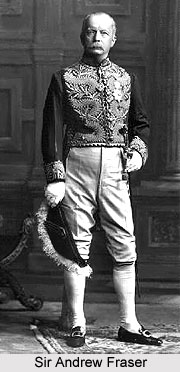 Andrew Fraser, formally known as Sir Andrew Henderson Leith Fraser, KCSI was the prominent Lieutenant Governor of Bengal Presidency from the year 1903 to 1906, in undivided India under the rule of the British Empire. He also served as a member of the Indian Civil Service (ICS). Fraser was born on 14 November 1848 to Scottish parents. He received his education from the Edinburgh Academy. Later he was called to the Bar at the Middle Temple. Eventually in the year 1871, Sir Andrew Henderson Leith Fraser joined the British Indian Civil Service, which was the civil service of the Government of India during the era of the rule of British Empire in India. The members of the civil service were appointed under Section XXXII of the Government of India Act, 1858 of the Parliament of the United Kingdom. After the year 1886, the Indian Civil Service was officially known as Imperial Civil Service.
Andrew Fraser, formally known as Sir Andrew Henderson Leith Fraser, KCSI was the prominent Lieutenant Governor of Bengal Presidency from the year 1903 to 1906, in undivided India under the rule of the British Empire. He also served as a member of the Indian Civil Service (ICS). Fraser was born on 14 November 1848 to Scottish parents. He received his education from the Edinburgh Academy. Later he was called to the Bar at the Middle Temple. Eventually in the year 1871, Sir Andrew Henderson Leith Fraser joined the British Indian Civil Service, which was the civil service of the Government of India during the era of the rule of British Empire in India. The members of the civil service were appointed under Section XXXII of the Government of India Act, 1858 of the Parliament of the United Kingdom. After the year 1886, the Indian Civil Service was officially known as Imperial Civil Service.
Sir Andrew Fraser served in the Central Provinces for around 30 years as an Indian Civil Servant. Later in 1897, he was knighted with the Companion of the Most Exalted Order of the Star of India (CSI) and was appointed as a Knight Commander of the Most Exalted Order of the Star of India (KCSI) in the year 1902. Fraser was eventually promoted to the ranks of the Chief Commissioner of Central Provinces in the year 1899 and was later in 1902, he was appointed as the President of Police Commission.
Sir Andrew Henderson Leith Fraser, KCSI was appointed as the Lieutenant Governor of Bengal in 1903. The Bengal Presidency originally comprised east and west Bengal and was a colonial region of the British Empire in India. The region included the territories of undivided Bengal like West Bengal, Tripura, Orissa, Meghalaya, Bihar, Assam and modern Bangladesh. He was preceded by James Bourdillon in the post of the Lieutenant Governor of Bengal. Fraser held the designation of Lieutenant Governor of the Western province of Bengal even after the Partition of Bengal in the year 1905. But his participation in the planning of partition of Bengal made him unpopular amongst the nationalist agitators. Moreover an assassination attempt was also made in the year 1907 by derailing his train. In November 1908, another failed attempt was made to assassinate Lieutenant Governor Sir Andrew Fraser. He was succeeded by Sir Lancelot Hare in the year 1906.
Andrew Henderson Leith Fraser, KCSI wrote and published several book such as "Among Indian Rajahs and Ryots" in 1909 and "India under Curzon and After" in 1911. He died on 26 February 1919.



















